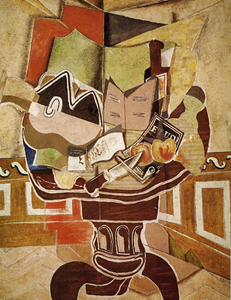Georges Braque - La Belle Epoq - Story of the Day!
- LaBelleEpoq

- Nov 27, 2020
- 2 min read
Updated: May 21, 2021

Georges Braque is a French painter, graphic artist, set designer, sculptor and decorator. In 1907, after visiting the workshop of Pablo Picasso, Braque abruptly changed his artistic manner, striving for more laconicism in pictorials and geometrization of objects. He is considered a co-founder of Cubism along with Picasso.
Between 1909 - 1912 Braque collaborated with Picasso on theorizing the foundations of Cubism. At that time, while Picasso was influenced by Gauguin, African tribal masks and Iberian sculptures, Braque experimented digging into Cézanne's idea - with a multitude of perspective points of view.

Braque's paintings in 1908 - 1913 reflect his then interest in geometry and perspective, intensively studying the effects of light and perspective. In his painting "Houses in Estaque" (fr. Maisons à l'Estaque, 1908), Braque brings the architectural structure into a geometric shape close to a cube. He further rendered the shading so that it looks flat but three-dimensional. Thus, Braque drew attention to the very nature of visual illusions and artistic representation.

When we think of Cubism, the first name that comes to mind is Pablo Picasso. On the internet, in blogs and in most articles, related one way or another to Cubism, Georges Braque is only rarely mentioned (if mentioned at all) as a co-founder of Cubism.
There are few articles on Braque's contribution to the foundation of this revolutionary art style, about how he and Picasso challenged and influenced each other's work. Let's uncover the relationship between the reserved Frenchman and the explosive Spaniard.
Georges Braque showed up at Pablo Picasso's studio in the spring of 1907 to see the acclaimed "Maidens of Avignon" painting. Braque, a Fauvist himself, was a member of this rebellious art movement who made a lot of noise in Paris since a couple of years.

What he saw that day in Picasso's workshop was something beyond his imagination: frank, deliberate, impudent "irregularity" of the Avignon Maidens, simplified forms, broken figures and distorted proportions stunned Braque. This was the debut of a friendship with this strange Spaniard that Braque desired at all costs.
Over the course of next months, the works of Picasso and Braque greatly mutually influenced laid the foundation and gradually crystallized the new style changed forever the world of art.
Their unique union perfectly synergized two personalities, two minds, two creative energies.

The main idea of Cubism was the rejection of the traditional belief that art should serve as an imitation of reality. This stylistic path was already paved before with form experiments by Paul Cézanne, whom Braque and Picasso worshipped.
Despite some visual similarities in their works, two artists focused on different objects and pursued different directions. Picasso tried to get away from representativeness, Braque experimented with materials, textures, manipulations with light and space.
If Braque strove to ensure a sense of balance and harmony preserved in his paintings, Picasso, on the contrary, dare to break this harmony and balance.











Comments